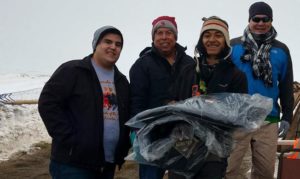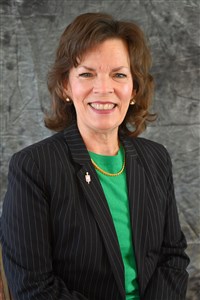 April 3 marks the anniversary of one of the most significant events in modern Native American history. It was the start of the #NODAPL movement, the Standing Rock Sioux Tribe’s protest against building a 1,200-mile-long Dakota Access Pipeline that would run near the reservation, threatening the tribe’s water supply and sacred sites. The tribe estimates 17,000 “Water Protectors” from around the world passed through the Sacred Stone Camp from April 2016 to February 2017, including United Methodists who came to show support and witness something they say will never happen again in their lifetimes.
April 3 marks the anniversary of one of the most significant events in modern Native American history. It was the start of the #NODAPL movement, the Standing Rock Sioux Tribe’s protest against building a 1,200-mile-long Dakota Access Pipeline that would run near the reservation, threatening the tribe’s water supply and sacred sites. The tribe estimates 17,000 “Water Protectors” from around the world passed through the Sacred Stone Camp from April 2016 to February 2017, including United Methodists who came to show support and witness something they say will never happen again in their lifetimes.
“My biggest regret is that I wasn’t out there longer,” said Eshtakaba LaFromboise, 22, a member of First American United Methodist Church, Norman, Oklahoma. He, along with family members, joined the protests for 10 weeks from August to early October. They chose to camp along the river so they could begin every day at sunrise with prayer and song. During the first couple of months, he said, only 300 to 400 people, all of whom were Native Americans, participated.
“There was no need to keep track of time or money; no need for electricity or running water,” he said. “It was like stepping back in time, and I was actually just a young Indian boy in the middle of camp. It felt like we got a taste of how our people use to be.”
 Dallas Parker, 27, a member of the North Oklahoma City Fellowship, made several trips with the Oklahoma Indian Missionary Conference of The United Methodist Church and also describes the family-like atmosphere they experienced with each visit.
Dallas Parker, 27, a member of the North Oklahoma City Fellowship, made several trips with the Oklahoma Indian Missionary Conference of The United Methodist Church and also describes the family-like atmosphere they experienced with each visit.
“The way everybody would greet each other was like they have always known one another,” he said. “Standing Rock gave our Native people something to believe in again. The movement offered us hope, knowledge and lifelong friendships between people, who, without this movement, would not have had the opportunity to share stories, laugh and pray together.”
The Rev. Sharon Yeahquo, who visited Standing Rock with members of the United Methodist Church of Apache, Oklahoma, volunteered in one of the eight kitchens set up to serve the Water Protectors.“People were arriving at the camp at all hours, some driving, others walking; the food was to be available to everyone,” said Yeahquo. She recalls being very honored when she was asked to prepare a plate of food to take to the elder’s circle so they could bless the food. The first elder took the plate, prayed over the food and sang a song. The plate was then passed to the other elders.
“I looked at the elders’ faces as each reached for the plate and passed it on to the next,” she said. “They had expressions of passion, determination, comfort, support and love. I heard ‘thank you’ from the elders in several languages.” The firekeeper received the plate and emptied the food into the fire. Yeahquo said she felt humble and thankful to be there.
Throughout the protests, The United Methodist Church alongside the OIMC provided food, water, tents, shade, winter coats, toiletries and grooming items, and sent multiple teams to support the efforts onsite.
“When Native American leaders called for religious leaders to come to Standing Rock, we showed up,” said the Rev. Susan Henry-Crowe, general secretary of the General Board of Church and Society, who visited Standing Rock in September. She said the denomination’s 2012 commitment made during the Act of Repentance to Indigenous Peoples service at General Conference requires an ongoing relationship with Native peoples.
“Repentance is not a one-time thing,” Henry-Crowe explained. “We must continue to do the work to repair broken relationships and restore wholeness.”
“In my lifetime, there has not been anything like Standing Rock that has grabbed the world’s attention and shown a spotlight on Native rights issues the way this has,” said the Rev. David Wilson, Oklahoma Indian Missionary Conference superintendent. “Water is life, and it is fundamental to many of our Christian teachings and our traditional beliefs.”
As the violence escalated between Water Protectors and police, and with the start of winter, the dy namics of the camp changed. LaFromboise was there when dogs were brought in to intimidate Water Protectors. He was also there in October when police sprayed pepper-spray infused water and rubber bullets at Water Protectors in 13-degree temperatures.
namics of the camp changed. LaFromboise was there when dogs were brought in to intimidate Water Protectors. He was also there in October when police sprayed pepper-spray infused water and rubber bullets at Water Protectors in 13-degree temperatures.
For many reasons, including the dangerously cold temperatures, the camps closed in February 2017. The tribe continues to battle against the pipeline through the courts even today.
“It took me a while to get my mind right after the camps closed,” said LaFromboise. “They were so special. I wasn’t there when they came down, and then they were just gone. It was difficult to deal with.”
 “When OIMC first started to support Standing Rock, I wanted the people to know when the camps ended that our support did not,” said Wilson. OIMC has continued to work with Standing Rock on a number of issues including suicide prevention. The United Methodist Committee on Relief has also been involved in supporting food relief and support for Native people suffering from recent floods in North Dakota and South Dakota.
“When OIMC first started to support Standing Rock, I wanted the people to know when the camps ended that our support did not,” said Wilson. OIMC has continued to work with Standing Rock on a number of issues including suicide prevention. The United Methodist Committee on Relief has also been involved in supporting food relief and support for Native people suffering from recent floods in North Dakota and South Dakota.
Even though the camp folded, people from all over the world still visit the site according to Jen Jewitt, logistics coordinator for the Standing Rock Sioux Tribe’s Emergency Task Force. She said people come asking to see where the camp was located and where the drilling began.
“Standing Rock proved that we still have our spiritual laws and protocols; we still sing and pray together and care for one another,” said Jewitt. “This was a one-time deal. There will never be a Standing Rock moment like this one.”
“Ultimately, this experience showed me how wonderful and beautiful my Indian people are,” said LaFromboise. “It gave me a great sense of identity of who I am as an indigenous person and a closer connection to God.”


